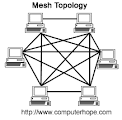The
term network topology refers to the
layout of a network. The type of topology affects what networking method is
used, as well as what cable types and network devices are required. Network
topologies can be defined on a physical level or on a logical level. The
physical topology refers to how a network is physically constructed — that is,
how it actually looks. The logical topology refers to how a network looks to
the devices that use it—in other words, how it actually functions.
There
are a number of different network topologies, and a network may be built using
multiple topologies. The different types of network layouts are:
·
Bus topology
·
Star topology
·
Ring topology
·
Hybrid topology
Bus topology: A linear bus topology consists of a main run of cable with a
terminator at each end. All nodes (file server, workstations, and
peripherals) are connected to the linear cable.
Features:
·
Uses a single length of cable.
·
Devices connect directly
to the cable.
·
The cable must be terminated
at both ends.
Advantages:
·
It is inexpensive and
easy to implement.
·
Requires less cable
length than a star topology.
Disadvantages:
·
Entire network shuts
down if there is a break in the main cable.
·
Terminators are required
at both ends of the backbone cable.
·
Difficult to identify
the problem if the entire network shuts down.
·
Not meant to be used as
a stand-alone solution in a large building.
·
It cannot be expanded
easily.
Star topology: A star topology is designed with each node (file
server, workstations, and peripherals) connected directly to a central network
hub, switch, or concentrator. Data on a star network passes through
the hub, switch, or concentrator before continuing to its destination. The hub,
switch, or concentrator manages and controls all functions of the network. It
also acts as a repeater for the data flow. This configuration is common with
twisted pair cable; however, it can also be used with coaxial cable or fiber
optic cable.
Features:
·
Devices connect to a central
point.
·
Each system uses an individual
cable to attach
·
Multiple stars can be combined
to create a hierarchical star.
Advantages:
·
Easy to install and
wire.
·
It can be easily expanded
without disruption to existing systems.
·
Easy to detect faults
and to remove parts.
Disadvantages:
·
Requires more cable
length than a linear topology.
·
It requires additional networking
equipment to create the network layout.
·
If the hub, switch, or
concentrator fails, nodes attached are disabled.
·
More expensive than
linear bus topologies because of the cost of the hubs, etc.
Mesh topology: The
mesh topology is unique: It requires each computer on the network to be
individually connected to every other device. This configuration provides
maximum reliability and redundancy for the network. If one cable or link fails,
the data can use an alternate path to get to its destination.
Features:
·
A true mesh uses point- to-point
connectivity between all devices.
·
A hybrid mesh uses
point-to-point connectivity between certain devices, but not all of them.
Advantages:
·
Multiple links provide fault
tolerance and redundancy.
·
The network can be expanded
with minimal or no disruption.
Disadvantages:
·
It is difficult to
implement.
·
It can be expensive
because it requires specialized hardware and cable.
Ring topology: In the ring
topology, the network layout forms a complete ring.Computers connect to the network
cable directly or, far more commonly, through a specialized network device. On a
ring network, data travels in one direction, passing from on computer to the
next until it reaches the intended destination.
Features:
·
Devices are connected in
a closed loop or ring.
·
Dual-ring configuration can
be used for fault tolerance.
Advantages:
·
It is easy to
troubleshoot.
·
Can be implemented in a
fault tolerant configuration
Disadvantages:
·
A cable break can
disrupt the entire network.
·
Network expansion
creates network disruption.
5-4-3
Rule
A consideration in
setting up a tree topology using Ethernet protocol is the 5-4-3 rule. One
aspect of the Ethernet protocol requires that a signal sent out on the network
cable reach every part of the network within a specified length of time. Each
concentrator or repeater that a signal goes through adds a small amount of
time. This leads to the rule that between any two nodes on the network there
can only be a maximum of 5 segments, connected through 4
repeaters/concentrators. In addition, only 3 of the segments may be populated
(trunk) segments if they are made of coaxial cable. A populated segment is one
that has one or more nodes attached to it . In Figure 4, the 5-4-3 rule is
adhered to. The furthest two nodes on the network have 4 segments and 3
repeaters/concentrators between them.
NOTE: This rule does not
apply to other network protocols or Ethernet networks where all fiber optic
cabling or a combination of a fiber backbone with UTP cabling is used. If there
is a combination of fiber optic backbone and UTP cabling, the rule would
translate to a 7-6-5 rule.The speed of networking switches is vastly improved
over older technologies, and while every effort should be made to limit network
segment traversal, efficient switching can allow much larger numbers of
segments to be traversed with little or no impact to the network.
Considerations When Choosing a Topology
·
Money. A linear bus network may be the least expensive way to install a
network; you do not have to purchase concentrators.
·
Length of cable needed. The linear bus network uses shorter lengths of
cable.
·
Future growth. With a star topology, expanding a network is easily done by
adding another concentrator.
·
Cable type. The most common cable in schools is unshielded twisted pair,
which is most often used with star topologies.







0 nhận xét:
Post a Comment